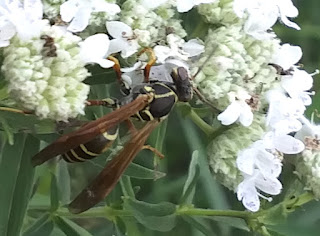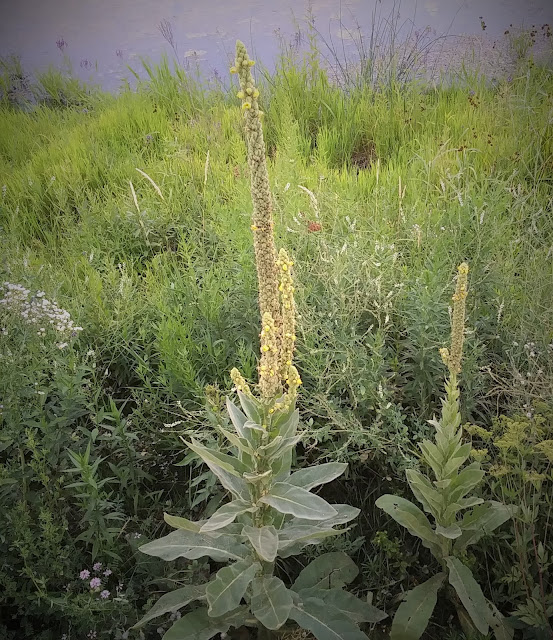A volunteer plant in the area around the pond - - Maltese Cross.
7/31/2021
maltese cross
A volunteer plant in the area around the pond - - Maltese Cross.
7/28/2021
convivial ducks
This summer has been very scant on rainfall so far. The pond water level is currently low, and there is plenty of algae floating. But the rocks are always good places for sharing the sunshine. Female Mallard and Hooded Merganser have raised their young broods here, and shared the big rock today.
7/23/2021
mountain mint
7/20/2021
evening primrose
7/19/2021
7/17/2021
royal catchfly
Royal Catchfly Silene regia makes its bright red flowers stand out among the white and purple wildflowers now blooming.
This family of plants was named 'catchfly' because it has a sticky seed pod behind the flower. Little flies, gnats, and other tiny insects get stuck on the sticky pod or stem.
Butterflies also pollinate this wildflower.
7/15/2021
mulleins
7/11/2021
barn swallows
Barn Swallows hunt over the pond, where they catch flying insects mid-air. To do this efficiently, they fly with their wide beaks open.
This pair found a good amount of food here, and decided to make their nest nearby. They gathered mud from the shore to paste pieces of grasses to a vertical surface in a barn, outbuilding, or nearby structure.
When their eggs hatch, the pond area will be a resource for mosquitoes and other flying insects to feed to their chicks.
7/07/2021
white wildflowers
Sitting near the pond, one can gaze out at flowering plants among the green grasses, rushes, and reeds. Mountain Mint, Swamp Milkweed, and Queen Anne's Lace are among the ones blooming now.
7/04/2021
yellow loosestrife
Small yellow wildflowers, brightening the green grasses and rushes around the pond now, are River Loosestrife Lysimachia hybrida, or Lowland Yellow Loosestrife. This plant bloomed last year, and came back stronger with more stems this season. Lysmachias produce floral oil rather than nectar. These plants are also pollen hosts for Macropis bees; the bees specialize in using a mixture of pollen and floral oil to produce offspring. read more at U of MN Extension
7/03/2021
7/02/2021
6/27/2021
gleeful painted turtle
The painted turtles who live in the pond love to sit in the sun, especially on rocks near the water. There, each can enjoy the warmth and (in case of danger) slip into the water to hide if needed. This young little critter, about 4 inches long, looked so gleeful today with its feet extended out to catch as much sunshine as possible.
new Mallards, second clutch
Mallard female has been hiding her second clutch of eggs near the pond among grasses. Today she led all 6 hatched ducklings to the pond, where they paddled around and started to feed. They can eat seeds, stems, and roots of many different plants; also aquatic invertebrates such as worms, beetles, dragonflies, or insect larvae.
6/25/2021
scouring rush
Scouring Rush Equisetum hyemale grows in the wetland around the pond. It is also called 'horsetail'.
6/24/2021
galls on goldenrod
6/22/2021
widow skimmer
This dragonfly male 'Widow Skimmer' Libellula luctuosa shows off his handsome transparent wings with black and white structural coloration -- the production of color by microscopically structured surfaces fine enough to interfere with visible light.
The grass seedhead on the left is close to the camera and in front of the wing. But the rush stem behind the wing is showing clearly through the transparent wing while the skimmer rests, clasping that stem.
He is probably looking for prey -- other insects such as mosquitoes. To catch prey he will use his legs, and bring prey into his mouth with fangs.
nesting mallard
6/21/2021
great blue heron
Stealthily, this Great Blue Heron appeared on the shore this afternoon. It stood still for only a little while, looking for prey; they eat fish, frogs, aquatic creatures, even small mammals. Is it a male and female? Great Blue Herons Ardea herodias look alike except for their size, so more likely to tell if we can see them in pairs.
6/20/2021
crown vetch
A creeping plant that was used in the past as erosion control on embankments and roadsides, Crown Vetch Securigera varia is sprinkled among the grasses and rushs around the pond. Pretty lavender and purple blossoms among the greens, but it can take over native plants in this area.
Since this is a non-native invasive plant that can compete with native wildflowers, we will be removing it or cutting it back.
6/19/2021
mullein
Several Mullein plants are growing in the riparian zone around the pond. The plants are small rosettes of fuzzy leaves, close to the ground, the first year of their growth. The second year, Common Mullein Verbacum thapsus shoots up a stem clad in very fuzzy leaves topped by a flower spike (left).
Once the flower blooms, it is a brilliant torch of yellow blossoms. Each blossom has 5 petals, and stays open for a short time. Thus, the spike may have only a few blossoms open at a time.
6/17/2021
meal for green heron
Green Herons nest in trees and shrubs near water, or dry woods and orchards as long as it provides seclusion and there is water nearby for foraging fish or frogs.
Last year we saw a Green Heron Butorides virescens several times here on the pond shore, hunting for a meal. To see those previous photos and information about how these birds use tools to hunt, enter heron in the search box at top left then press return.
































